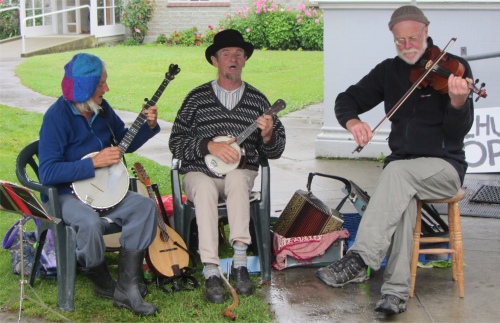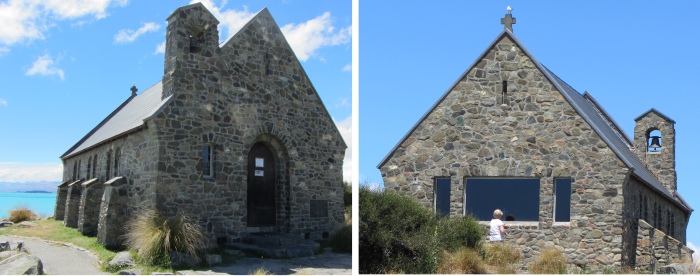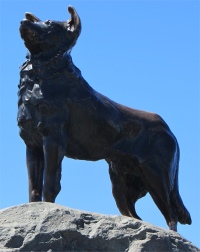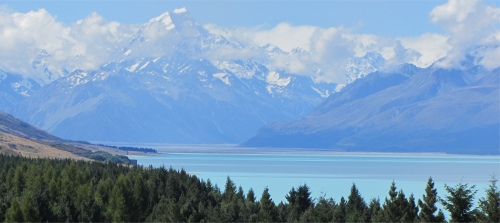
Mount Cook Beyond Lake Pukaki
|
The star-studded night skies above Tekapo and the Mackenzie Basin had been noted for their clarity. For that very reason Mount John, on the shores of Lake Tekapo, was selected as the ideal site for an observatory, the internationally renowned Mount John Observatory; truly one of the most beautifully situated observatories in the world. Surrounded by glacial lakes, moraine and the Southern Alps, the observatory offered incredible 360 degree views of the surrounding countryside.
I headed up to the observatory to get a bird's eye view of the area, and also see what was open to the public. I and a couple managed to get talking to Chris, an astronomer based at the observatory, and for the price of a gold coin for the upkeep of the place, he gladly shared his time and knowledge with us. There were several telescopes on the mountain top, provided by the USA, Germany, Japan and one or two other countries. In fact there was only one New Zealand telescope here. However, New Zealand totally managed the complex. As the site was being established, there had been a shortfall in funds to the tune of $0.5M. This jeopardised a lot of the work, but rescue came from a couple of local business men. They put up the funds if the complex could be opened up to the public. It was a no brainer really, and to ease the worried minds of the astronomers with regard to security, the businessmen took care of all those aspects and the staffing to boot. Hence the reason why I and about 80 others were up there on what had become a remarkably clear day.
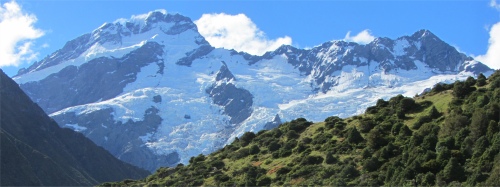
Snow Covered Peaks Above White Horse Hill Campsite
|
Chris let us gaze at the sun through a special telescope. Sunspots and solar flares were clearly visible. That was magical. In addition, he took us inside one of the domes where we could observe Venus through a 16" x200 magnification reflecting telescope. The astronomical authorities at the site were currently specialising in near earth objects. Apparently, recently an asteroid the size of a container ship passed between the earth and the moon. That would be big enough to take out the whole of Australia. There are smaller objects which pass closer than some of the satellites that orbit the earth. I suggested that there must be a policy not to inform such matters to the general public so as to avoid wide spread panic. The observatory was also investigating earth like planets in the heavens.
I enquired about night viewing opportunities, and indeed there were, cloud cover permitting of course. However, at this time of year, the viewings don't start until after 11pm. Sadly, I would not be hanging around to enjoy the star-gazing opportunities. I would need to use my car to reach the place, and it wouldn't be good policy to return to a campsite at 2 or 3 in the morning.
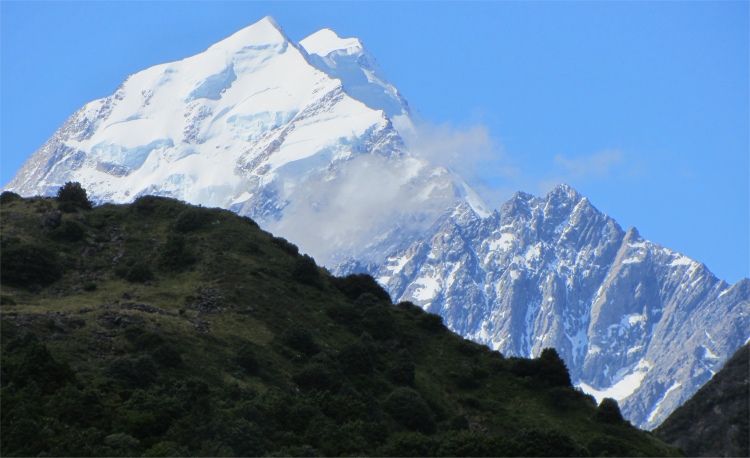
Clear View of Mount Cook
|
Instead I continued my way to another extraordinarily turquoise blue lake, Lake Pukaki, crossing a turquoise canal as I went. Lake Tekapo was the highest lake, which fed via the canal into Lake Pukaki, and then onto another series of lakes and dams. In the course of its journey, the waters powered twelve hydroelectric plants. Looking up the 30km long Lake Pukaki, I was treated to a picture postcard view of Mount Cook in the far distance. I took a right turn and followed the western shore of the lake through tussock lands up to Aoraki Mount Cook Village.
The encircling horseshoe of mountains I was entering was the indicator that I was now approaching a cul-de-sac, as far as four wheels were concerned, and I soon found myself driving into the Aoraki Mount Cook Village. The village didn't appear to be anything to write home about, but functionally served as the hub for all the regional activities. On every side, the Southern Alps scraped the sky.
The most well known building in the village was the Hermitage, possibly one of the most renowned hotels in the country due to its spectacular outlook; Mount Cook. The original hotel was built further up the valley in 1884, but a flash flood in 1913 devoured it. A second Hermitage was rebuilt on the current site, but it was devoured by fire in 1957. The current Hermitage was constructed on the same site. I wonder if a new disaster will eventually devour it.
I cooked a meal using a New Zealand variety of sweet potato, and it was quite palatable. Because I was surrounded by high mountains, sunset was quite early, though the evening glow lasted a while down the open stretch over Lake Pukaki. I took a stroll to the Alpine Memorial which stood close to the site of the old Hermitage on the Hooker Valley Track. This memorial commemorates all people who have lost their lives on this mountain. Attached around it are individual plaques attached by friends and relatives of just some of those who have been killed, with quite touching tributes. It was a sombre reminder of how dangerous these peaks and the rapidly changing weather conditions can be.
